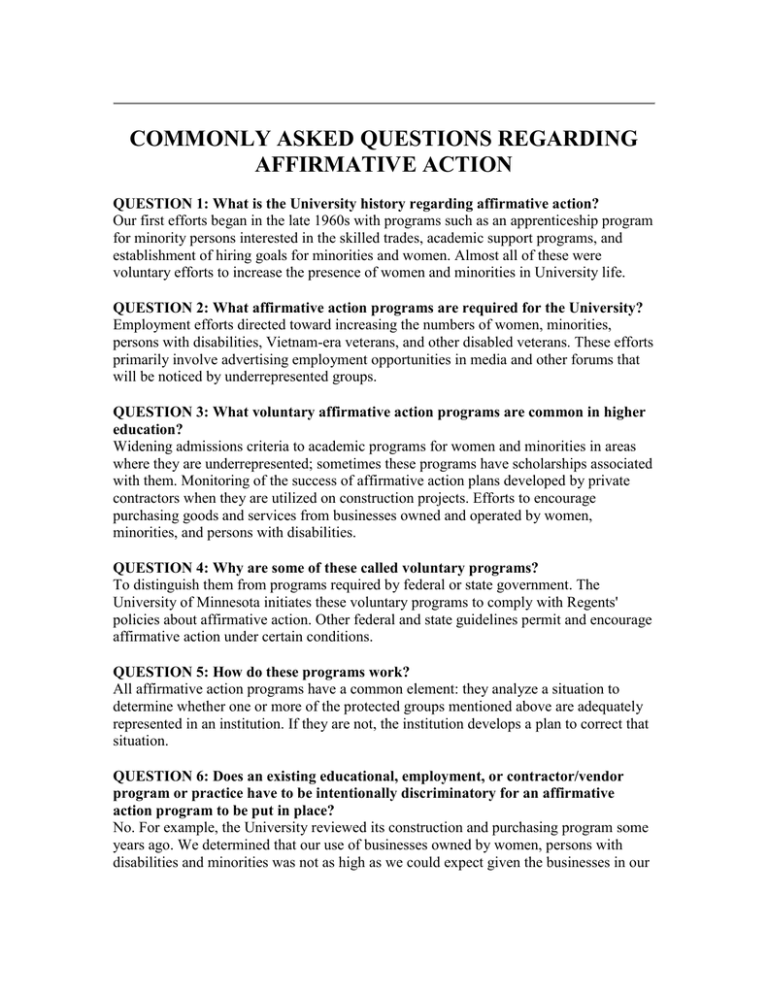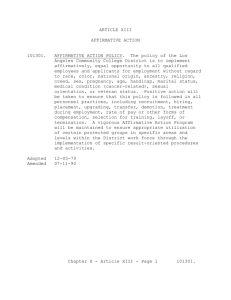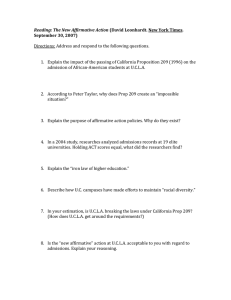commonly asked questions regarding affirmative action
advertisement

COMMONLY ASKED QUESTIONS REGARDING AFFIRMATIVE ACTION QUESTION 1: What is the University history regarding affirmative action? Our first efforts began in the late 1960s with programs such as an apprenticeship program for minority persons interested in the skilled trades, academic support programs, and establishment of hiring goals for minorities and women. Almost all of these were voluntary efforts to increase the presence of women and minorities in University life. QUESTION 2: What affirmative action programs are required for the University? Employment efforts directed toward increasing the numbers of women, minorities, persons with disabilities, Vietnam-era veterans, and other disabled veterans. These efforts primarily involve advertising employment opportunities in media and other forums that will be noticed by underrepresented groups. QUESTION 3: What voluntary affirmative action programs are common in higher education? Widening admissions criteria to academic programs for women and minorities in areas where they are underrepresented; sometimes these programs have scholarships associated with them. Monitoring of the success of affirmative action plans developed by private contractors when they are utilized on construction projects. Efforts to encourage purchasing goods and services from businesses owned and operated by women, minorities, and persons with disabilities. QUESTION 4: Why are some of these called voluntary programs? To distinguish them from programs required by federal or state government. The University of Minnesota initiates these voluntary programs to comply with Regents' policies about affirmative action. Other federal and state guidelines permit and encourage affirmative action under certain conditions. QUESTION 5: How do these programs work? All affirmative action programs have a common element: they analyze a situation to determine whether one or more of the protected groups mentioned above are adequately represented in an institution. If they are not, the institution develops a plan to correct that situation. QUESTION 6: Does an existing educational, employment, or contractor/vendor program or practice have to be intentionally discriminatory for an affirmative action program to be put in place? No. For example, the University reviewed its construction and purchasing program some years ago. We determined that our use of businesses owned by women, persons with disabilities and minorities was not as high as we could expect given the businesses in our location. The Office of the Senior Vice President for Finance developed a program to respond to this situation. QUESTION 7: Why is there such strong reaction against affirmative action? There are many misconceptions about Affirmative action. MYTH: Affirmative Action forces institutions to lower their standards when hiring. REALITY: No affirmative action plan calls on an institution to lower its standards for the hiring or advancement of employee. Minorities and women on campus have to meet the same, basic standards for promotion, tenure, or pay raises as their white male colleagues. Indeed, many women and minority employees believe they must actually do better than the standard in order to be considered equal to the white male population. MYTH: There are just no qualified women and minorities for some positions, or it takes too much time to find them. REALITY: Enlarging the pool of candidates and treating all candidates equitably and fairly is more a function of will than of time. The fact is that, for just about any job you can think of, there are many qualified women and minorities. A dedicated effort to diversify a work force employs a variety of strategies designed both to make these candidates aware of the position and to diversify the pool of qualified applicants. MYTH: Affirmative action is just reverse discrimination against white males. REALITY: Traditionally, discrimination in America excluded minorities and women from many opportunities. Affirmative Action does not bar white males from any opportunity. Affirmative Action seeks only to remedy the effects of discrimination. Indeed, even where affirmative action is actively pursued, white males are highly successful in securing jobs. MYTH: Affirmative action goals and quotas are the same thing. REALITY: Employment goals and quotas have certain similarities: both are used to bring about change, and both are measurable. But, in essence, goals and quotas are quite different. Quotas define results in terms of specific numbers and are externally imposed upon an institution. Goals are internally-generated and use targets to measure success. Often, those who are charged with achieving goals are actually involved in establishing them. MYTH: Affirmative action reserves jobs for women or minorities. REALITY: A job made available under affirmative action is not reserved for a candidate of minority or female status. Affirmative action guarantees only that no qualified candidate -- of any group -- will be excluded from the pool of those being considered. QUESTION 8: Wouldn't it be more fair to use "gender and race blind" screening? Affirmative action requires first and foremost that we recruit individuals from underrepresented groups in numbers which mirror their presence in the workforce. Secondly, it requires that we screen those persons with great care to be sure that all qualified individuals advance through the process. The screening process need not be "blind" to achieve fairness; thorough review of credentials based on well defined and job related criteria does the most to achieve fairness. QUESTION 9: If we want to hire or admit underrepresented persons, why don't we just set aside some places for them, or interview only underrepresented persons? It is clear that such a procedure would distort affirmative action by creating a situation where gender or race alone would bar someone from an opportunity. While those factors are permissible as one factor in a set of criteria, they may not be used as the sole criterion. QUESTION 10: Does the law require a particular procedure, such as use of a search committee, in an Affirmative Action Plan? No. An institution is free to develop its own procedures. As long as the procedures are job related and do not arbitrarily screen out protected groups, they are permissible. QUESTION 11: Does affirmative action work? Affirmative action programs work if they are implemented with overall fairness and consistency. The key to a workable program in any affirmative action area, but especially in employment, is aggressive recruitment activity and objective and responsible selection criteria so that all groups, including protected groups, advance through the system. No system works if it is only a paper procedure. The University of Minnesota is an Equal Opportunity Educator and Employer

